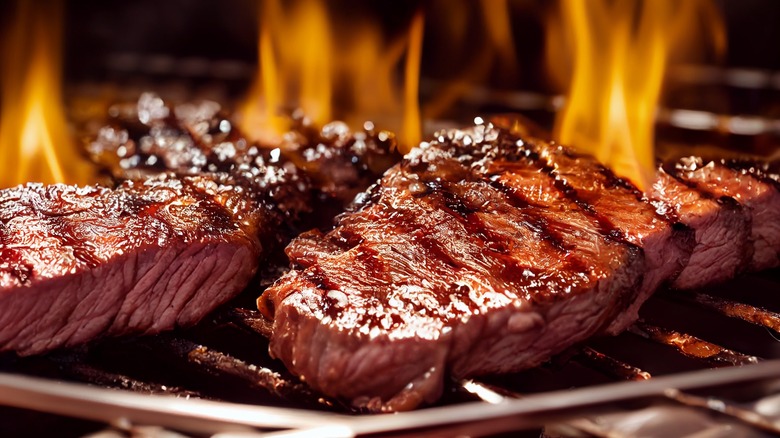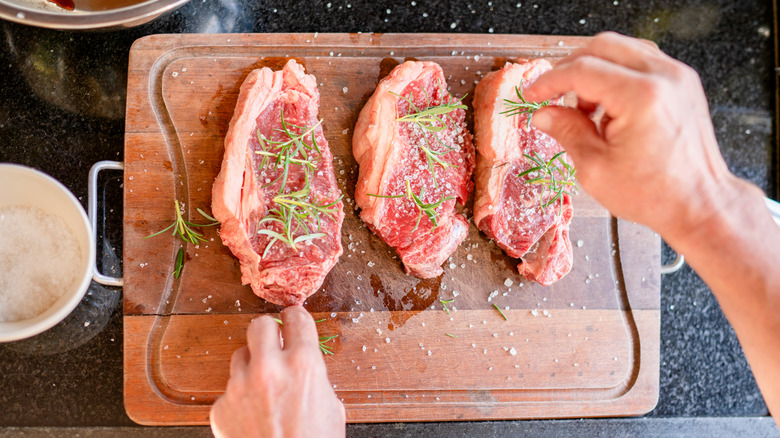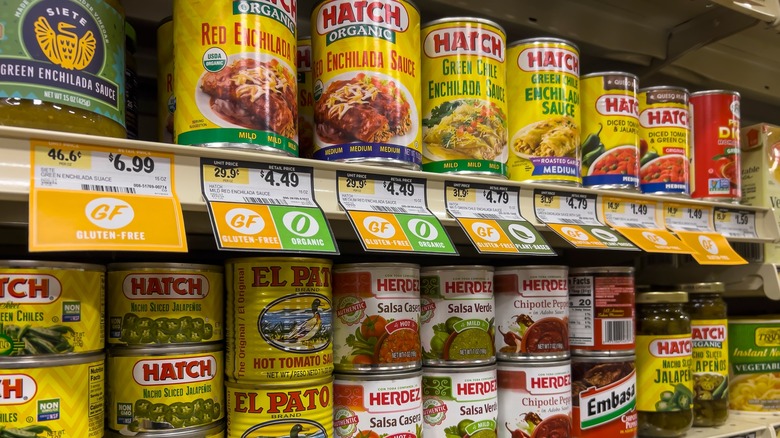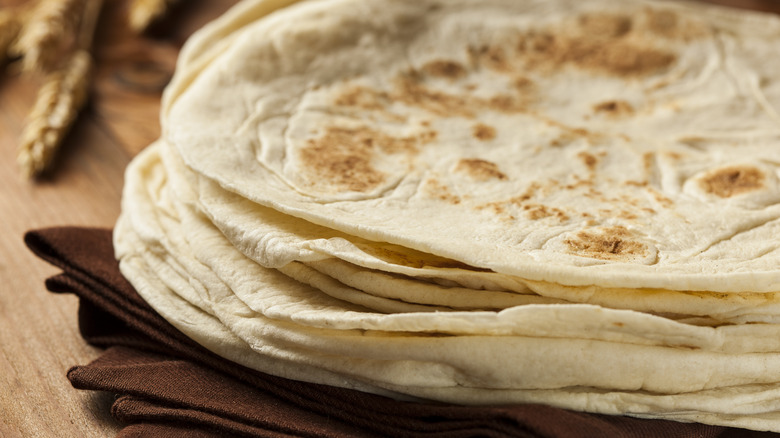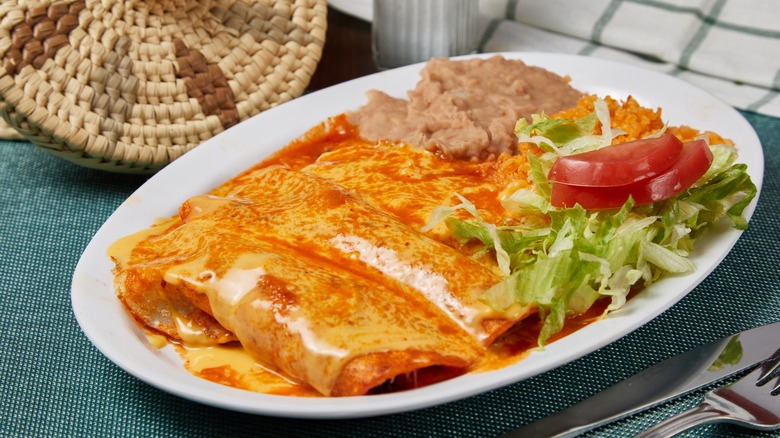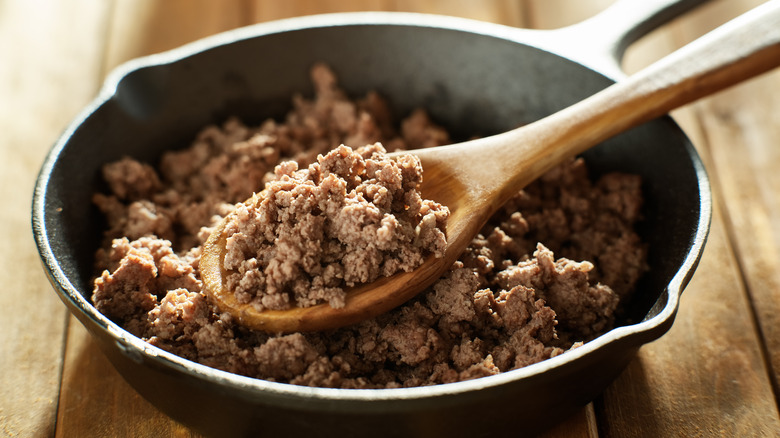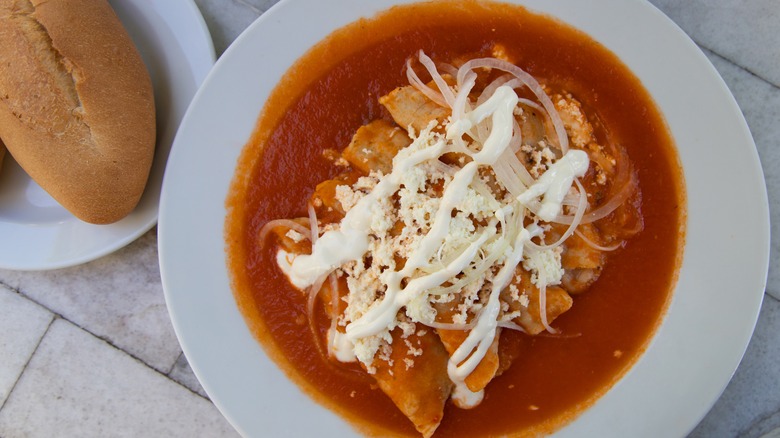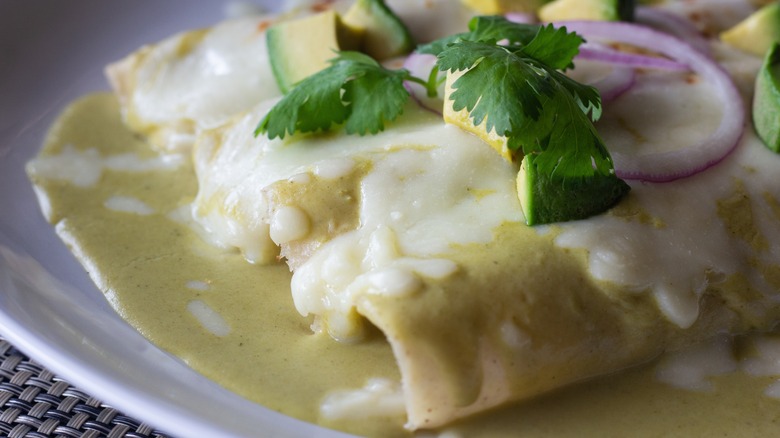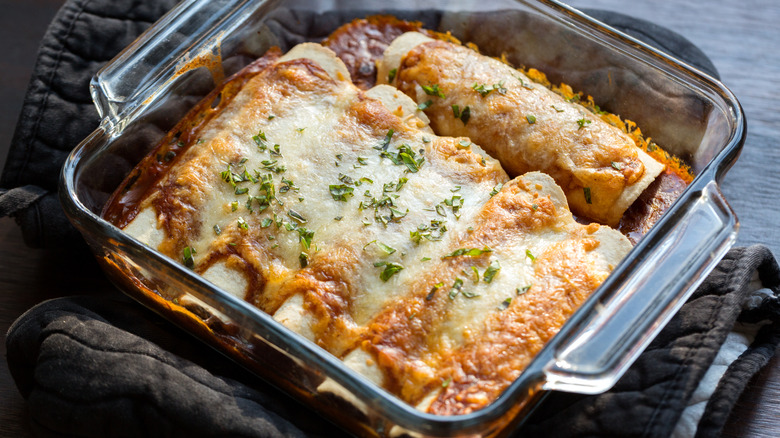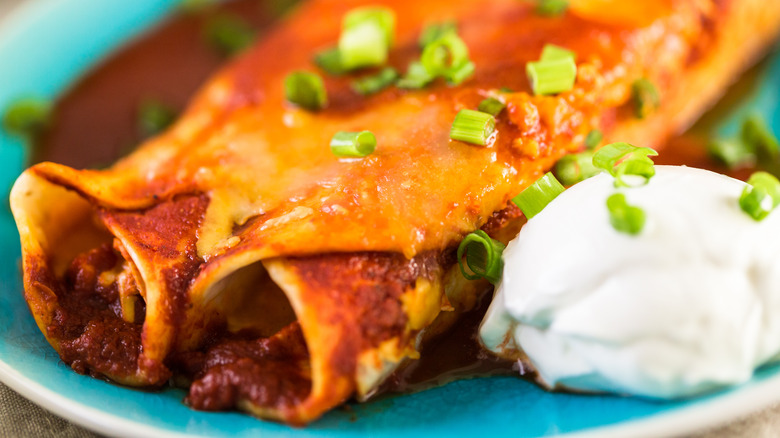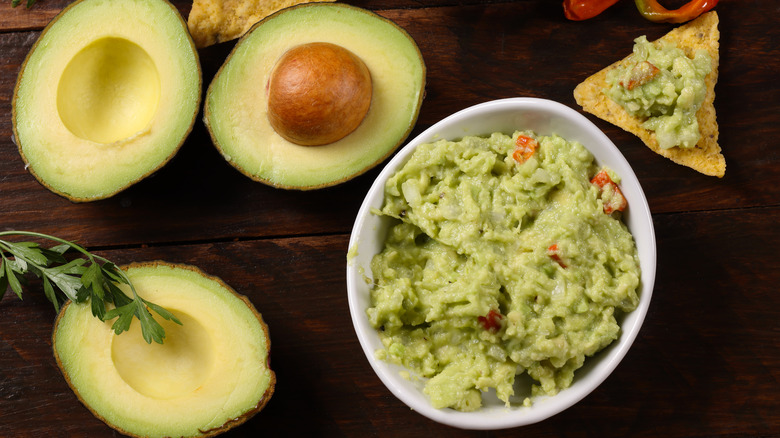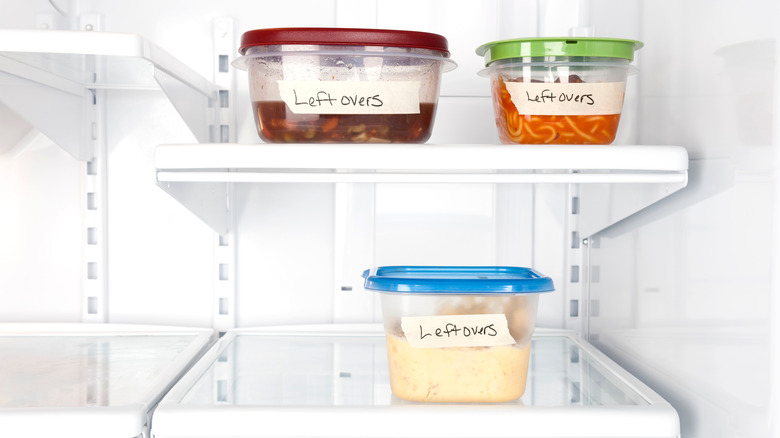13 Mistakes You're Making With Beef Enchiladas
Mexican food. Do we have your attention yet? Cuisine from Mexico is internationally renowned for its unique, bold flavors and its creative combinations. Tortillas have been a staple of Mexican cuisine since before the arrival of the Spanish in the 1500s, and there is evidence that indigenous people in Mexico ate food wrapped in tortillas, which is the precursor to many of the Mexican dishes we know and love today — including enchiladas.
Beef enchiladas are a crowd favorite when it comes to Mexican food. The meaty, umami taste of beef mixed with spicy, smoky enchilada sauce and topped with bubbling cheese produces a symphony of flavors that envelop the taste buds in a warm embrace. But beef enchiladas can be intimidating.
Pitfalls abound on your path to making the perfect beef enchiladas, but once you know which errors to avoid, you'll be sending yourself and all your dinner guests to enchilada heaven. Read on to find out about the mistakes you're making with beef enchiladas and how to never make them again.
Overcooking your beef
Chewy is not the word that should come to mind when you're thinking about beef enchiladas. You should be indulging in a tender, juicy pocket of beefy goodness that falls apart with the touch of a fork, which is why you need to be careful not to overcook the beef in your enchiladas.
The muscle fibers in a piece of beef are composed of a mixture of protein and fat, and the reason your steak is so chewy when you overcook it is that the fat melts out of the muscle and takes the moisture with it. Instead of having a nice piece of steak that melts in your mouth, you've got to chew for what feels like an eternity. If you accidentally overcook your beef, don't worry, not all is lost. A simple method to save overcooked meat is to chop it up into little bits and mix a bit of oil in to replenish some of the fat that was lost when the meat was overcooked. To mask your meaty indiscretion further, cover your enchiladas with guacamole and sour cream for added moisture — your dinner guests will be none the wiser.
Not seasoning the beef properly
Beef without seasoning is like a day without sunshine. You can't just rely on the other flavors in your enchiladas, delicious as they may be, to carry your dish into culinary excellence. And how you decide to season your beef depends on a few key factors.
If you're making your steak with a lean meat like flank steak, you might consider marinating it before it hits the grill to tenderize the beef and infuse it with extra flavor. It's crucial to season marinades because it's an easy way to bring flavor to your meat, and the right amount of salt helps bring out the other flavors in the marinade. If you're using a fattier piece of meat, it's still important to salt it. Salt doesn't just bring out the delicious natural umami flavors of the beef — it also acts as a tenderizer and breaks down the muscle fibers on the exterior of the meat to make your cut extra tender and juicy. Also, consider how spicy you want your beef to be. If you want to give it a good kick, add some chile powder or cayenne pepper to your seasoning, and if you're going for a smoky flavor without the heat, stick to spices like cumin and paprika.
Relying on canned enchilada sauce
Don't get us wrong — there are plenty of great things about canned enchilada sauce. It's cheap, convenient, and provides the smoky, savory flavor that enchiladas are known for. Although it may be more labor-intensive, there is no substitute for using fresh ingredients to make your own enchilada sauce. Especially when it comes to making beef enchiladas, making your sauce from scratch allows you to customize the flavor to create a sauce that stands up to the savory flavors of beef.
Because canned enchilada sauce is so commonly used, you may not even know what's inside or how you would go about making it yourself. Homemade red enchilada sauce starts with dried guajillo and ancho chiles, which you can buy at most Mexican grocery stores. Once they're softened up with some boiling water, brown onions and garlic in a pan and blend them with the chiles, canned tomatoes, chicken broth, spices, salt, vinegar, and honey until you reach that rich consistency and deep red color. It may take a bit of extra effort, but cooking from scratch allows you to avoid processed ingredients, preservatives, and sweeteners, and it always tastes better. If you don't have time to make your own sauce, you can also amplify canned enchilada sauce by sauteing some fresh garlic, onion, and peppers and mixing them into your sauce for some added flavor.
Using flour tortillas
There's nothing corny about loving flour tortillas. These white, pillowy discs are perfect for Tex-Mex specialties like burritos, fajitas, and chimichangas, but they just don't stand up to the task of beef enchiladas. Corn tortillas are heartier, sturdier, and healthier, which is part of the reason they've been a bedrock of Mexican cuisine for thousands of years while flour tortillas only came around after European colonization.
Corn tortillas are the traditional choice for beef enchiladas. This is partly because corn tortillas have an earthy, slightly nutty flavor profile that complements the spicy, bold flavors that usually fill them in Mexican cuisine. But, perhaps more importantly, corn tortillas have a structure that can hold up to 20 minutes in an oven smothered in sauce without falling apart. Flour tortillas are softer, and if you use them to make enchiladas, they'll absorb the liquid in the enchilada sauce, get soggy, and fall apart when you try to get them onto your plate. Instead of a neat row of rolled-up savory sensations, you end up with a goopy mess.
Not preheating your tortillas
When you serve enchiladas, you should be able to lift each rolled-up tortilla out of the dish as a single unit, for both presentation and taste (the tortilla is a separate flavor element meant to be eaten as such). The juices from the beef on the inside and the smothering embrace of enchilada sauce on the outside of each tortilla can easily make it soggy and threaten its structural integrity. But at the same time, the tortillas need to be pliable enough to roll up and snuggle next to one another in the baking dish. Cold tortillas are brittle and crack easily, so you'll have to preheat them before filling them with beef.
If you quickly fry each tortilla in hot oil, it creates a barrier between the tortilla dough and the liquids, which makes it less likely to get soggy in the oven. Right after you fry each tortilla, put it on a paper towel to get rid of excess grease and then quickly dip it in enchilada sauce so that it becomes just soft enough to roll your beef into without cracking and falling apart.
Not draining the beef
Beef has a fantastically fatty finish that gives each bite of enchiladas a forkful of flavor. That said, too much grease can make your beef enchiladas heavy and greasy and leave a gross feeling in your mouth that detracts from the other flavors. To make sure that you don't end up with too much grease in your dish, make sure to drain off the excess fat after your beef is done cooking and before you wrap it in tortillas.
This tip is especially important when it comes to ground beef, which can release a lot of liquid during the cooking process that can threaten the flavor and structure of your enchiladas. There are a few easy ways to get rid of excess liquid from ground beef, but you should never drain ground beef in the sink because it can congeal and clog your drain. Instead, push the beef to one side of your pan and gently tilt the liquid into a bowl. Once it cools off, place the grease in a plastic bag and throw it away in the trash can.
Overloading the filling
When you look at a plate of beef enchiladas, each roll should be neatly tucked next to its neighbor in an aesthetically pleasing little lineup. You should be able to easily lift each enchilada out of the pan and plate it as a single unit, not a soppy mess where you can't tell where one enchilada ends and the next begins, which is why it's crucial not to fill your enchiladas with too much beef.
Put in just enough beef to where you can comfortably close the tortilla so that it looks like a taquito with just a bit of beef visible on either end. A good rule of thumb if you're using corn tortillas, ones the size of your hand, is to use about 2 tablespoons of filling per enchilada. Before they go in the oven, place your enchiladas in your baking pan with the "seam" side of the enchilada facing down. If your enchilada is overfilled, the filling will fall out of either end of it and you'll know you need to take some beef out and distribute it to another enchilada. A loaded beef enchilada is perfectly plump and can hold its own, but an overloaded enchilada is not a recipe for success.
Skipping the cheese
Cheese makes everything better. If meat is the star of beef enchiladas, then cheese is the supporting cast. Flavor-wise, cheese adds a distinct savory, creamy saltiness to beef enchiladas, and this combo does something magical when it hits your taste buds, especially if you leave your enchiladas in the oven just long enough for the cheese on top to crisp up just a bit to give you a slightly charred, smoky taste. But when it comes to beef enchiladas, not all cheeses were created equal.
Mexico's stretchy Oaxaca cheese stands out from the rest for its rubbery texture, which melts beautifully in the oven on top of your enchiladas. Oaxaca cheese (named after a state in southwestern Mexico where it is a part of the local cuisine) has the mild, nutty flavor of Monterey Jack, but the consistency of mozzarella, which makes it perfect for melting. If you don't have Oaxaca, you can use just about any melting cheese, so long as it isn't so pungent that it will compete with the other flavors in the dish. On top of that (because one kind of cheese is never enough), you can crumble some queso fresco on top once your enchiladas are out of the over, which is another type of Mexican cheese that has a salty bite similar to feta and adds a creamy texture.
Underestimating garnishes
Once your enchiladas are out of the oven, you may think it's time to just go ahead and dig in, but you're missing a crucial step. If you've ever eaten at a Mexican restaurant, you know that the cuisine does not go light on the garnishes. A taco alone often comes with cilantro, lime, red onions, lettuce, and even pineapple. And although the bulk of the work of making beef enchiladas is over once they're sitting there steaming on your countertop, finishing the dish with a few carefully selected garnishes will take your beef enchiladas to the next level.
One common garnish is pickled red onions, which are super easy to make at home and lend your enchiladas a bold, acidic bite that cuts through the fatty flavors of the beef. Fresh cilantro not only gives enchiladas a beautiful splash of green color, but an herbaceous, slightly citrusy flavor that adds freshness and a characteristic Mexican flavor. A squeeze of lime juice can also brighten up the heavier beef notes and rounds your enchiladas out with a zing of flavor.
Adding too much sauce
As we've established, sogginess is the natural enemy of the enchilada. One way to turn a neat plate of enchiladas into a messy, soggy beef enchilada soup is to add too much sauce. We get it, you've worked hard on making an incredible enchilada sauce and you want it to take center stage, but if your enchiladas turn out soggy, don't say we didn't tell you so. You can always refrigerate leftover sauce if you need to.
Also, too much sauce can leave you wondering what happened to your beef. Beef is, after all, the main character in beef enchiladas, and you want it to shine in the limelight. When adding the sauce, be sure to add enough to coat all of the enchiladas, but be sure that you can still see the tops of the tortillas. When it comes to adding enchilada sauce, it's all about moderation.
Skipping the sour cream or yogurt
Enchiladas should be enjoyed nice and hot, but plopping a few dollops of sour cream on top is a great way to cool it down while adding some flavors that elevate the overall dish. A scoop of cold or room-temperature sour cream tones down the heat in more ways than one, since sour cream is helpful for reducing the spice factor of a dish. Although sour cream is the traditional choice, you can also use yogurt, which has a lower fat content than sour cream but adds the same tartness, which balances out the bold flavor of beef enchiladas.
The texture of both sour cream and yogurt is rich and exactly the creamy addition your beef enchiladas need. For creamier enchiladas with a thick, bold filling, try adding yogurt or sour cream to the beef mixture itself and mixing it all together before you place it inside the tortillas.
Omitting avocado
There's something suspicious about people who don't like avocado. To reject the buttery golden-green perfection of a ripe avocado on top of your beef enchiladas is to neglect the potential of what beef enchiladas can be. For one, it's pleasing to the eye to have some color variation on your plate, and the light green of the avocado really makes a plate of red enchiladas pop. Avocados are also full of healthy fats and a great source of vitamins and minerals, which is one more reason why they're so popular.
Instead of using just avocado, you can also make guacamole to top your enchiladas. It has a creamy texture and is full of fresh ingredients that contrast with the intense flavor and saltiness of the beef in the enchiladas. And if you want more heat, adding a hot chile pepper to your guacamole is a great way to kick things up a notch.
Not saving some for later
Beef enchiladas are a labor of love. If you're making your sauce from scratch (as we recommend you do), you'll be in the kitchen for a good bit of time before your enchiladas are ready to serve, so you might as well make a whole heaping batch because they make for great leftovers. You can keep enchiladas in the fridge for three or four days and keep them in the freezer for two or three months if they're well-sealed in a container.
When you get a hankering for a spicy, beefy, cheesy plateful, there are plenty of ways to reheat leftover enchiladas so that they're as good as the day you made them. The best way is to use the oven, which heats your enchiladas evenly, but takes a while and might not be practical for single servings. If time is of the essence, you can use the microwave to reheat your beef enchiladas, though this method will usually give you a soggier result.

